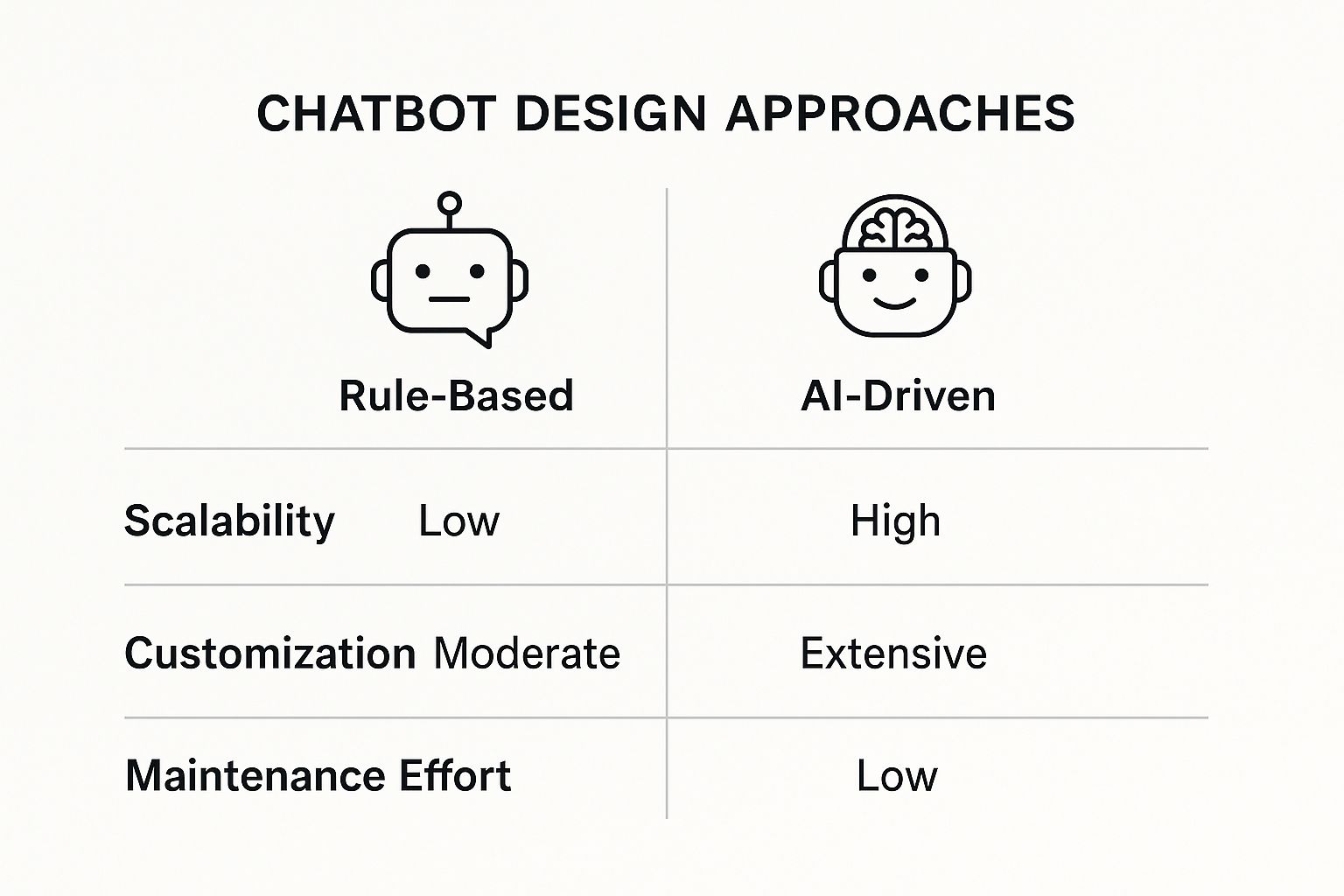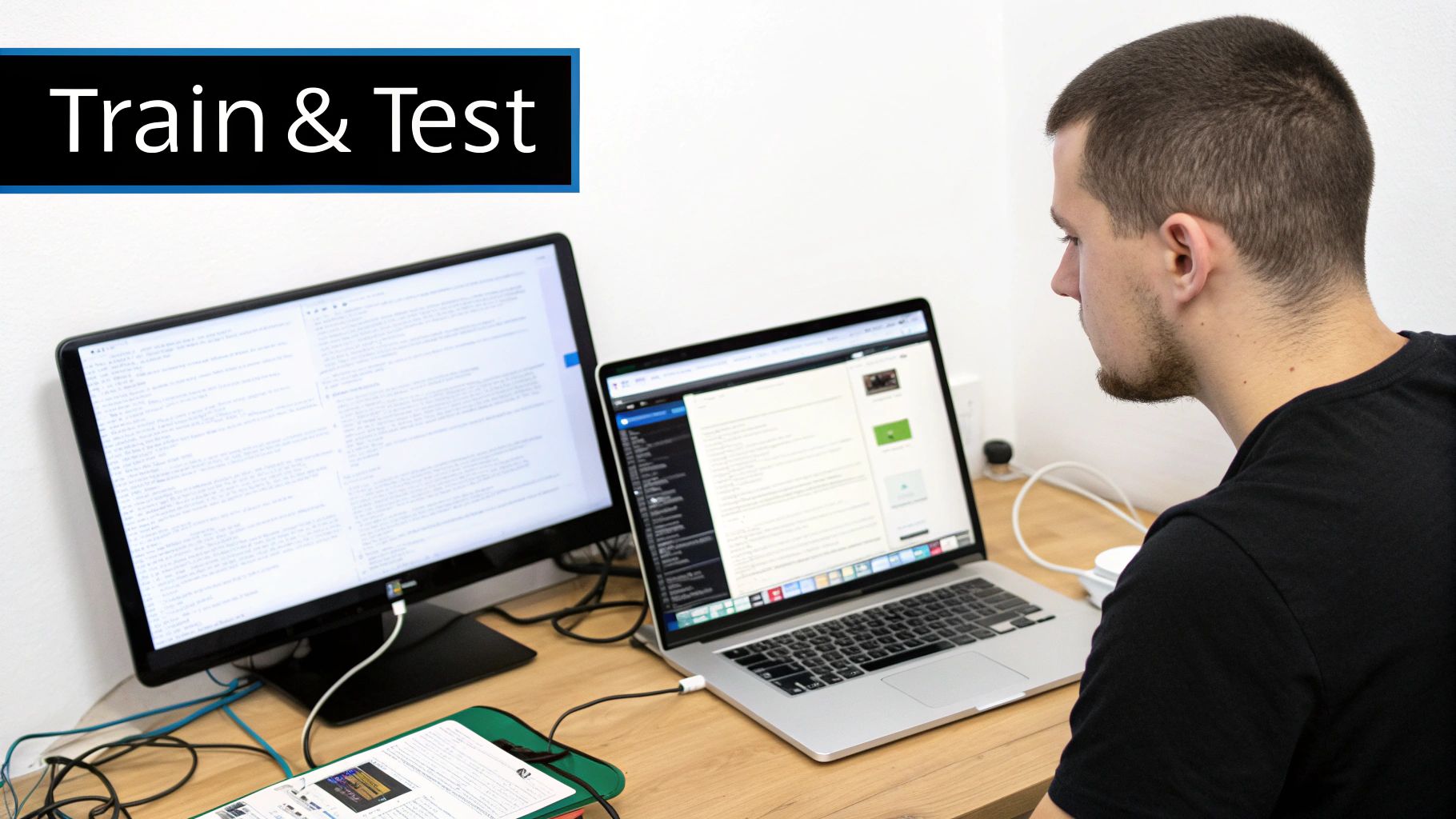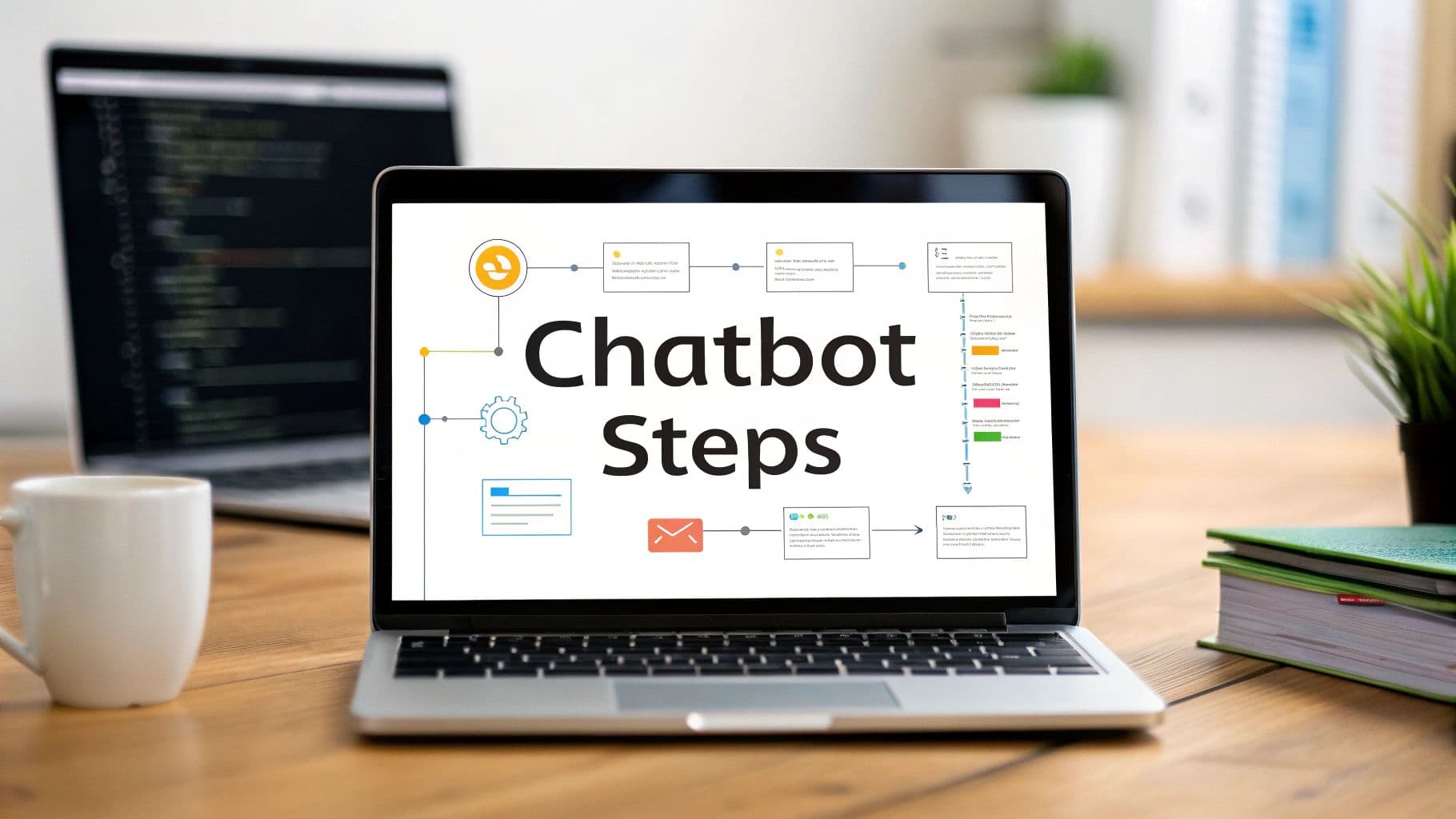chatbot implementation steps
AI conversation design
customer experience
business automation
digital transformation
Chatbot Implementation Steps: A Practical Guide
The Evolving Chatbot Landscape: What You Need to Know First

Today’s chatbots are far more advanced than the basic, rule-based systems of the past. These tools are evolving into complex AI assistants, changing how businesses operate. This shift presents both exciting possibilities and potential challenges for organizations considering implementing chatbots.
Understanding the Current State of Chatbots
The global chatbot market is dynamic and expanding rapidly. Market valuations are a testament to this, with estimates ranging from $100 million to $5 billion by 2025. This wide range highlights the fast-paced growth and evolving methodologies in the sector.
This growth is fueled by the demand for 24/7 availability, quick replies, and the ability to scale – all benefits that chatbots deliver. As of 2025, the US leads in global chatbot user penetration at 36%. India follows at 11%, with Germany at 4%. These figures reflect the increasing global reliance on chatbots for better customer service. Find more detailed statistics here.
Interested in learning more? Check out this resource on how to master building your own chatbot.
Key Factors for Successful Chatbot Implementation
Successful chatbot implementation hinges on several key factors. Understanding your business needs is paramount. Blindly following tech trends without a clear goal can result in an ineffective and frustrating user experience.
-
Identify High-Impact Use Cases: Concentrate on areas where a chatbot adds significant value, such as responding to frequently asked questions or guiding users through simple tasks.
-
Secure Stakeholder Buy-In: Get key decision-makers on board by addressing their concerns and showcasing the potential return on investment (ROI) of chatbot implementation.
-
Establish Meaningful Metrics: Go beyond basic engagement metrics. Track completion rates and customer satisfaction to measure your chatbot’s true impact.
Avoiding Common Implementation Pitfalls
Many chatbot projects fail due to poorly defined strategies, inadequate conversation design, or a lack of ongoing optimization. A chatbot delivering canned responses or failing to understand user intent quickly leads to frustration.
Careful planning and execution are essential throughout every stage of implementation. By understanding the current landscape, defining a clear strategy, and prioritizing the user experience, organizations can harness the power of chatbots. Ultimately, this helps improve customer service, boost efficiency, and achieve business goals.
Defining Your Chatbot Strategy: From Wishful Thinking to Results
The most successful chatbot implementations prioritize strategy. This means developing a plan aligned with your business needs, not just chasing the latest tech. Organizations seeing positive results from chatbots often start by identifying key use cases and getting stakeholder buy-in. They also use metrics that measure more than just user engagement.
Conducting a Needs Assessment
Before starting chatbot implementation, a thorough needs assessment is crucial. This involves mapping your customer journey and finding where a chatbot adds the most value. For example, a chatbot could handle FAQs, freeing up human agents for complex issues. Needs assessments also help define realistic timelines and resource needs based on your objectives.
Prioritizing Implementations for Maximum Impact
Focusing on high-impact uses ensures your chatbot delivers real results. This might mean automating repetitive tasks, providing instant support, or guiding users through complex processes. It also means understanding the limits of different chatbot designs. The infographic below compares two main approaches: Rule-Based vs. AI-Driven.

As the infographic shows, rule-based chatbots require more upkeep but offer decent customization. AI-driven chatbots scale better and offer extensive customization with less maintenance. The best choice depends on your needs and resources. For more information, check out this resource: How to master B2B SaaS.
The following table offers a more detailed comparison of various chatbot types:
To help you choose the best chatbot for your business, we've put together a comparison of different types. The table below details their capabilities, complexity, and ideal uses.
Chatbot Types and Their Business Applications
| Chatbot Type | Implementation Complexity | Technical Requirements | Best Use Cases | Typical Implementation Timeline |
|---|---|---|---|---|
| Rule-Based | Low to Moderate | Basic scripting, platform integration | Simple FAQs, lead capture, basic navigation | 2-4 weeks |
| Keyword Recognition-Based | Moderate | Natural Language Processing (NLP) integration | Handling more varied conversations, context recognition | 4-8 weeks |
| Machine Learning Chatbots | High | Training data, model development, API integrations | Personalized recommendations, complex issue resolution, proactive customer service | 8-12+ weeks |
| Hybrid Chatbots | Moderate to High | Combination of rule-based and AI techniques | Integrating the best of both worlds for a tailored experience | 6-10+ weeks |
As this table illustrates, different chatbots offer varied strengths. Simpler bots are quicker to implement but offer limited capabilities. More complex bots require more resources but can handle complex tasks.
Securing Stakeholder Buy-In
Getting support from stakeholders is key for smooth implementation. Clearly communicate the chatbot's benefits, address concerns, and show a clear return on investment. Stakeholders need to understand how a chatbot will improve customer satisfaction, reduce costs, or make operations more efficient. This creates collaboration and ensures everyone's on board with the project.
Establishing Meaningful Metrics
Measuring success is vital. This means looking beyond simple metrics like number of chats. Focus on metrics reflecting the chatbot’s impact on your goals. This could be customer satisfaction scores, issue resolution rates, or the percentage of tasks automated. Tracking these key performance indicators (KPIs) lets you find areas for improvement and show the chatbot’s value. The right strategy from the start is essential for impactful chatbot implementation.
Selecting the Right Platform: Beyond the Sales Pitch
Choosing the right chatbot platform is a crucial step in chatbot implementation. It impacts every aspect of your project's success, from how quickly you can develop and integrate your bot to its long-term maintenance and scalability. We'll help you navigate the complexities of platform selection, cutting through the marketing jargon and focusing on what truly matters.
Evaluating Core Capabilities
Don't be swayed by superficial bells and whistles. Concentrate on core functionalities that align with your chatbot strategy. A robust Natural Language Processing (NLP) engine is essential for accurate interpretation of user intent. When evaluating platforms, consider the following:
- NLP Capabilities: How effectively does the platform understand nuances in language, including slang and misspellings?
- Integration Options: Can the platform seamlessly integrate with your existing systems, such as your CRM and ERP?
- Scalability: As your business grows and user traffic increases, will the platform be able to handle the higher conversation volume?
- Total Cost of Ownership: Think beyond the initial price tag. Factor in ongoing maintenance, support, and potential upgrade costs.
Build vs. Buy: Making the Right Choice
Deciding whether to build a chatbot from scratch or utilize a pre-built platform requires careful thought. Building offers maximum customization but requires significant technical expertise and resources. A pre-built platform, on the other hand, provides a quicker route to launch but may limit flexibility. Consider these factors:
- In-House Expertise: Do you have the development team and AI specialists needed to build and maintain a custom chatbot solution?
- Time to Market: How urgently do you need to deploy your chatbot? Pre-built platforms can drastically shorten the implementation timeline.
- Customization Needs: How specialized are your requirements? If you need highly specific features, building a custom solution might be your only option.
This decision sets the stage for the entire chatbot implementation process. Factor in your budget, technical capabilities, and long-term goals. A well-informed decision now will save you time and resources down the line.
Vendor Assessment: A Practical Framework
Evaluating vendors requires more than just comparing features. Speak with businesses that have already used the platforms you’re considering. Inquire about their implementation experiences, the quality of vendor support, and whether the platform met their expectations. Look for vendors that offer:
- Transparent Pricing: Steer clear of hidden fees. Look for clear pricing structures and ensure you understand exactly what you're paying for.
- Strong Support: Reliable vendor support is critical, especially in the initial stages of implementation.
- Proven Track Record: Select platforms with a demonstrated history of successful implementations in businesses similar to yours.
A significant trend is the increasing adoption of chatbot integration by small and medium businesses (SMBs). Over 70% of SMBs anticipate using AI chatbots for customer service or sales by 2025, a significant increase from 45% in 2022. This growth is largely driven by no-code/low-code platforms. Learn more about this trend here.
Avoiding Common Pitfalls
Choosing the wrong platform can lead to costly re-implementations and project delays. Avoid these common mistakes:
- Ignoring Integration Needs: Make sure the platform seamlessly integrates with your existing business systems.
- Overlooking Scalability: Select a platform that can scale with your business and accommodate increasing user traffic.
- Focusing on Price Over Value: The most affordable platform may not offer the best long-term value. Prioritize features and functionality that align with your specific needs.
By following these steps, you can confidently select the right chatbot platform and set the stage for a successful implementation. The right platform will streamline the development process and ensure your chatbot effectively achieves your business objectives. This careful selection also lays the groundwork for future enhancements and integrations. The next crucial step in chatbot implementation is designing the user conversation flow. This element significantly impacts how users interact with and perceive your chatbot.

Conversation Design: Where Most Implementations Succeed or Fail
The difference between a beloved chatbot and an abandoned one often comes down to conversation design. Effective chatbots prioritize natural, efficient interactions that solve user problems. This means carefully crafting dialogue flows, aligning the chatbot's personality with your brand, and designing truly helpful interactions.
Mapping Conversation Flows: A User-Centric Approach
Think of a conversation flow as a map guiding users through their chatbot interaction. Each step should be intuitive, leading the user closer to their goal. Begin by identifying common user requests and create clear pathways to address them.
For example, users might want to check order status, schedule appointments, or access technical support. Each of these tasks requires its own dedicated conversation flow.
Crafting Personality: Reflecting Your Brand Voice
Your chatbot's personality should mirror your brand. A playful, informal tone might suit a trendy clothing brand, while a financial institution requires a more formal voice. Consistency is crucial. Maintain the same personality across all interactions for a cohesive brand experience. For further insight, check out this resource on prompt engineering for chatbots.
Designing Helpful Interactions: Prioritizing User Needs
Effective chatbots anticipate user needs and offer proactive help. This could involve suggesting relevant information, offering helpful tips, or providing clear next steps.
For instance, a travel agency's chatbot could anticipate visa requirement questions based on a user's destination and proactively offer that information.
Welcome Messages and Error Handling: Making a Good Impression
First impressions matter. A well-crafted welcome message sets the stage for the entire interaction. It should be friendly, informative, and clearly explain the chatbot’s function.
Equally important is error handling. When the chatbot encounters a problem, it should apologize and offer clear guidance. This could involve providing alternative options or escalating to a human agent.
To track performance and improve your chatbot, consider the metrics outlined in the following table.
This table outlines key performance indicators to track throughout your chatbot implementation process, helping you measure success and identify areas for improvement.
| Metric Category | Key Performance Indicator | Calculation Method | Target Benchmark | Improvement Strategy |
|---|---|---|---|---|
| User Engagement | Chatbot usage rate | (Number of chatbot interactions / Total website visits) * 100 | 20% | Promote the chatbot through website banners and pop-ups |
| Efficiency | First contact resolution rate | (Number of issues resolved on first contact / Total number of issues) * 100 | 75% | Improve conversation flows and knowledge base |
| User Satisfaction | Customer satisfaction score (CSAT) | Survey responses rating satisfaction with the chatbot interaction | 4 out of 5 stars | Address negative feedback and refine chatbot responses |
| Conversion Rate | Goal completion rate | (Number of successful goal completions / Total number of chatbot interactions) * 100 | 10% | Optimize conversation flows for specific user goals |
| Error Handling | Fallback rate | (Number of times the chatbot escalates to a human agent / Total number of chatbot interactions) * 100 | < 5% | Expand the chatbot's knowledge base and improve error handling logic |
By tracking these metrics, you can identify areas for improvement and optimize your chatbot for better performance.
Escalation to Human Agents: Knowing When to Hand Off
Chatbots excel at handling many tasks, but some require human intervention. Design your chatbot for seamless handoff to human agents when needed. This involves providing the agent with full conversation context for a smooth transition.
When choosing a chatbot platform, consider your specific needs. Top Platforms for Chatbots: Best Choices for 2025 offers a helpful starting point. Focusing on these key elements creates a positive user experience and drives positive business outcomes. Careful conversation design is essential for maximizing your chatbot's value, making it a true asset.
Technical Implementation: Beyond The Basics To Seamless Integration

A well-designed chatbot requires a robust technical implementation to truly succeed. This goes beyond simply setting up the software. It involves carefully considering data flow, system integrations, security, and rigorous testing. Let's explore the crucial technical steps to ensure your chatbot integrates seamlessly.
Establishing Secure Data Connections: Protecting User Information
Data security is paramount. Chatbots often handle sensitive user information, making secure data connections absolutely essential. This involves encrypting data both in transit and at rest. Implementing strong authentication protocols is also key. Furthermore, adhering to data privacy regulations, such as GDPR, is non-negotiable.
Regular security audits and penetration testing can identify and address vulnerabilities proactively. These measures not only build user trust but also protect your organization from potential data breaches.
Seamless System Integrations: Connecting Your Existing Infrastructure
Integrating your chatbot with existing systems, such as your CRM or knowledge base, unlocks significant potential. This integration enables the chatbot to access real-time information and perform actions on the user's behalf.
For instance, a chatbot integrated with a CRM can access customer purchase history, personalize support interactions, and even process orders. Careful planning is essential to prevent technical debt. Choosing a platform with robust API capabilities and following data exchange best practices are highly recommended.
Authentication and Data Privacy: Building Trust and Compliance
User authentication is another critical element of technical implementation. It verifies user identity before granting access to sensitive information or functionalities. Implementing methods like two-factor authentication and OAuth can enhance security significantly.
Maintaining data privacy is not just ethical; it's a legal requirement. Ensure your implementation complies with relevant regulations, especially if operating internationally. Clear communication about data handling practices builds trust with your users.
Businesses are increasingly adopting chatbots to automate tasks and improve customer support. Statistics show chatbots can handle 70% of customer conversations from start to finish. This efficiency leads to a 30% reduction in support costs and an 80% decrease in response times. Find more detailed statistics here.
Robust Testing Protocols: Identifying Issues Before Users Do
Thorough testing is essential before launching your chatbot. This involves testing conversation flows, integrations, and security measures. Several testing methods can be employed:
- Unit testing: Focuses on individual components.
- Integration testing: Checks the interaction between different parts of the system.
- User acceptance testing (UAT): Real users test the chatbot in a realistic environment.
Phased Rollouts and Feedback Loops: Refining Your Implementation
A phased rollout allows you to test with a smaller user group and identify remaining issues before a full launch. This controlled approach minimizes the risk of widespread problems and provides valuable user feedback.
Establishing clear feedback loops during implementation is also crucial. Provide easy ways for users to report issues and actively solicit feedback from your team. This continuous feedback is essential for identifying and addressing any problems quickly.
By prioritizing these technical implementation steps, you create a solid foundation for a successful chatbot launch. This ensures seamless integration within your existing systems and allows your chatbot to deliver real business value while improving the customer experience.
From Launch to Evolution: Making Your Chatbot Smarter Over Time
Launching your chatbot is a big step, but the journey doesn't end there. The most successful chatbots are the ones that constantly learn and grow. This means gathering user feedback, studying conversation data, and making changes to create a better user experience and achieve stronger business results. It's similar to training a new team member – regular feedback and guidance are crucial for their development and success.
Gathering Meaningful User Feedback: Listening to Your Users
Collecting user feedback is essential for chatbot improvement. This feedback can be explicit, like through surveys or feedback forms built into the chatbot itself. It can also be implicit, gleaned from analyzing conversation logs and spotting trends in user behavior. For instance, if users frequently exit the chatbot at a particular point in a conversation, it suggests a potential problem or area of frustration.
Identifying and Addressing Conversation Bottlenecks: Removing Roadblocks
Analyzing conversation data helps pinpoint where users get stuck. These bottlenecks can show up as high exit rates, repetitive questions, or requests to speak with a human representative. Imagine a chatbot for ordering food. If users consistently struggle to add items to their cart, this highlights a design flaw needing immediate attention. Fixing these bottlenecks leads to smoother, more satisfying interactions.
Prioritizing Improvements for Measurable Business Value: Focusing on Impact
Not every improvement is equally valuable. Focus on changes that have the biggest impact on your key business metrics. This might mean boosting conversion rates, lowering support costs, or improving customer satisfaction. Prioritizing these high-impact improvements ensures your chatbot optimization aligns with your overall business goals. As your chatbot evolves, think about integrating it with your document workflows, perhaps using intelligent document processing solutions to automate document handling.
A/B Testing and Evaluation: Measuring What Works
A/B testing is invaluable for assessing different conversation flows and design choices. By showing different versions to various user groups, you can gather data on which variations perform best. This data-driven approach ensures changes are based on real evidence, not just guesswork. It's a continuous cycle of experimenting and tweaking designs, much like perfecting a recipe – you adjust ingredients and methods until you achieve the perfect balance.
Expanding Capabilities Without Creating Confusion: Managing Growth
As your chatbot develops, you'll naturally want to add new features. However, a strategic approach is essential. Too many changes too quickly can overwhelm users and lead to confusion. A phased rollout, beginning with smaller additions and gathering feedback along the way, is key to managing growth effectively. This prevents feature overload and keeps the chatbot user-friendly.
Managing Organizational Aspects of Continuous Improvement: Collaboration and Communication
Successful chatbot improvement relies on effective collaboration within your organization. This requires clear communication between development, marketing, and customer support teams. Well-defined roles and regular feedback sessions are vital for keeping everyone aligned and ensuring chatbot improvements are implemented smoothly.
Resource Allocation and Stakeholder Communication: Keeping Everyone Informed
Chatbot improvement is an ongoing process that requires dedicated resources. This might include a budget for development, time for testing, and staff for ongoing maintenance. Clearly communicating these resource needs to stakeholders and providing regular progress updates is crucial for maintaining support and securing buy-in for future enhancements.
Boost your business with AnotherWrapper, a comprehensive AI toolkit for building and deploying advanced chatbots and other powerful AI applications. Start building today!
Fekri




